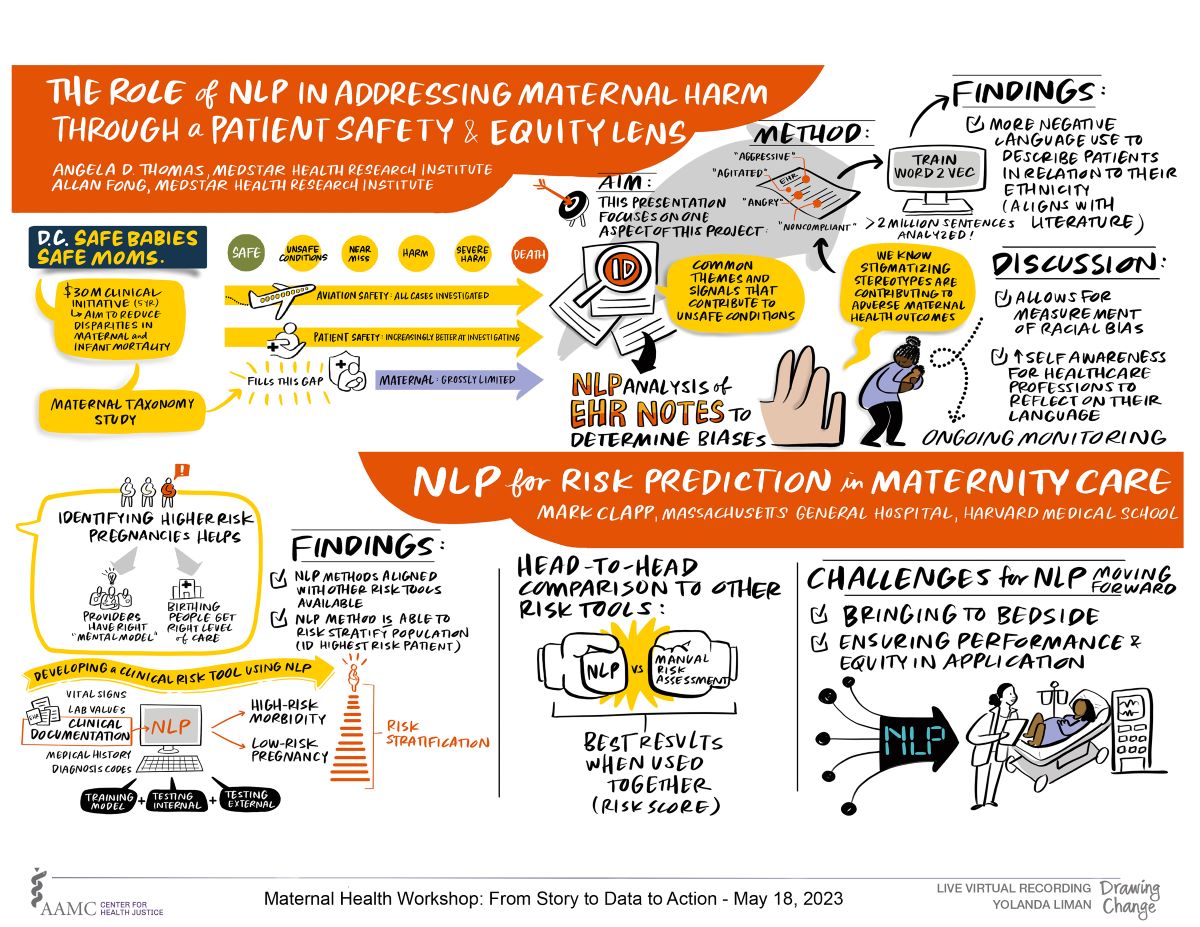
About this Graphic
This is a hand-illustrated graphic recording, created live during a keynote presentation at the Maternal Health Equity Workshop: From Story to Data to Action, May 18, 2023, which was convened by the Association of American Medical Colleges Center for Health Justice. Graphic recordings by Drawing Change. The effect is dynamic and organized into two main sections, top and bottom. There are limited illustrations in this piece and text is separated by background shading and different lettering sizes.
The Role of NLP in Addressing Maternal Harm Through a Patient Safety and Equity Lens
With Angela D. Thomas, Medstar Health Research Institute; Allen Fong, Medstar Health Research Institute
D.C. Safe Babies, Safe Moms
The first presentation is a $30M clinical initiative (5yrs); two yellow speech bubbles highlight these sentences: aims to reduce disparities in maternal and infant mortality; maternal taxonomy study.
An illustrated chart is drawn as a spectrum with circles. From left to right, the circles are connected by arrows and labeled: Safe; Unsafe; Near miss; Harm; Severe harm; Death (with the final circle on the right). Underneath, there are bars with three examples:
- Plane icon = aviation safety means all cases are investigated;
- Icon of hands caring = patient safety: increasingly better at investigating but;
- Icon of health protection shield with a figure holding an infant, but in a contrasting color; the bar only begins in the “near miss” section” and the text says “Maternal: Grossly limited.” The gap in the chart says “fills this gap” and it connects to the words “Maternal Taxonomy Study.”
This presentation focuses on one aspect of the project: NLP analysis of EHR notes to determine bias. A drawing of a magnifying glass on top of papers is accompanied by a speech bubble that reads “ID common themes and signals that contribute to unsafe conditions.”
Method
Drawing of an EHR record, with these words circled on it in red: “aggressive,” “agitated,” “angry,” and “noncompliant.” These words were inputted into a computer, trained Word2Vec, with 2 million sentences analyzed. highlighted speech bubble in yellow, with a Black woman holding her baby in a scared way and turning from a giant symbolic hand next to the word “biases.” The text says “We know stigmatizing stereotypes are contributing to adverse maternal health outcomes.”
Findings
More negative language is used to describe patients in relation to their ethnicity (which aligns with the literature).
Discussion
Allows for measurement of racial bias; provides opportunity for more self-awareness for health care professionals to reflect on their language. A dotted line connected to the words “Ongoing Monitoring.”
NLP for Risk Prediction in Maternity Care
With Mark Clapp, Massachusetts General Hospital, Harvard Medical School
Inside a circle, there are three cartoon pregnant people (with no visual identifying features). One of the three figures is colored orange with an exclamation mark above them. The text says, “Identifying higher risk pregnancies helps
- Providers have the right ‘mental model,’” along with an icon of three health care providers with a light bulb symbolizing ideas above their heads
- Helps birthing people get the right level of care, along with an icon of a hospital.
Findings
- NLP methods are aligned with other risk tools available
- the NLP method is able to risk stratify population (i.e., identify the highest risk patient).
Developing a Clinical Risk Tool Using NLP
A flow chart depicts three columns. On the left are these labels: Vital signs, lab values, medical history, diagnostic codes, and clinical documentation.
- The documentation is highlighted and arrows lead into the second column with a computer, indicating these data are fed into a computer.
- The computer says “NLP” on it. Underneath, these words explain the process: Training model + testing internal + testing external.
- The outputs from the computer are two choices: high-risk morbidity and low-risk pregnancy. There is a small figure drawn on top of a series of bars stacked like a pyramid, which visualizes the concept of risk stratification.
Head-to-Head Comparison to Other Tools
Two boxing gloves anchor the next section: NLP vs manual risk assessment. The best results are when they are used together (e.g., a risk score is calculated).
Challenges for NLP Moving Forward
Bringing it to the bedside; and ensuring performance and equity in application. This section has a small drawing of a female health provider helping a pregnant person with brown skin at the hospital bedside. Behind the health provider is a stylized digital drawing of points of data flowing into the letters “NLP” to show that the provider is supported by data.